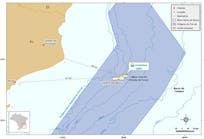Touchstone discovers additional hydrocarbons in Ortoire exploration
Touchstone Exploration Inc. released data from two tests of the Royston-1 exploration well on the Ortoire block, onshore in the Republic of Trinidad and Tobago. Both tests confirmed separate light oil discoveries.
The first and deepest Royston-1 completion and exploration test was designed to evaluate an interval at the bottom of the well in the intermediate sheet of the Herrera formation (OGJ Online Sept. 24, 2021). The completion spanned a 92-ft gross interval (30 ft net pay) below 10,434 ft that was identified on wireline logs as being hydrocarbon bearing. The well was shut in following completion and a brief clean-up period to recover load fluid, and it built to a pressure of 3,150 psi at surface (estimated 7,100 psi reservoir pressure). The interval was subsequently flowed up 3.5-in. tubing on a variety of choke sizes between 16/64 in. and 40/64 in. at rates up to 550 b/d.
The recovered oil was light, sweet crude with an average 33° API (corrected to 60° F.) with sampling throughout flow testing indicating an average 94% oil cut with some solution gas present but not measured. The configuration of the downhole assembly was not optimal for testing light oil given it was designed to test a potential liquids rich gas interval. The well continued to flow significant volumes of crude oil at high pressure from the intermediate sheet while the initial production test was suspended to move uphole for the second test. Heavy weight mud was required to control the well before proceeding.
The second production test was in the lowermost portion of the overthrust sheet at depths between 9,878 ft and 10,148 ft with a gross 270 ft of perforated section (202 ft net pay). The second test established a light oil reservoir in the overthrust sheet of the Herrera formation with flow rates of up to 430 b/d total fluid observed. Testing indicated light, sweet crude oil with an average 30° API (corrected to 60° F.), while build-up testing indicated a bottomhole reservoir pressure of 7,098 psi. Solution gas was also present on the test but was not measured. The downhole assembly for the test was designed for a liquids-rich natural gas test and again included 3.5-in. tubing which was not ideal for the actual conditions encountered following completion.
Unlike results from the first production test, the lower portion of the overthrust sheet produced with high water cuts averaging 90% throughout the second test. The completion was designed with multiple intervals to isolate production and, if a smaller tubing string is employed in the future, the interval can be segregated to maximize crude oil production.
